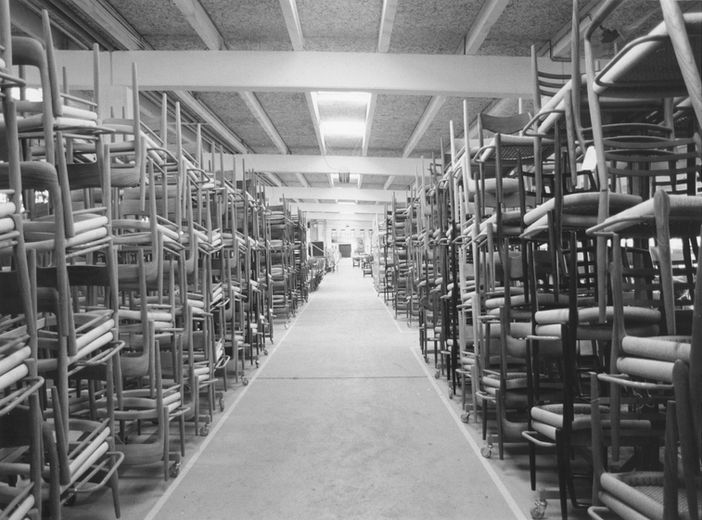Our identity
In 1944, Danish cabinetmaker Niels Otto Møller and his wife Kirsten Møller established a 50 m2 furniture workshop in the heart of Aarhus, transforming a former bicycle shed into J.L. Møllers. Initially, their work focused on custom-made dining and living room furniture, with Niels Otto personally crafting each piece in the small workshop and Kirsten sourcing high-quality materials and managing customer relations. In the early 1950s, the Møllers moved away from commission-based orders to serial chair production. Niels Otto designed and produced his own creations, marking the official beginning of the Møller Collection.
In 1951, he burst onto the design scene with his debut creations, the iconic 71 and 55 chairs. Immediately celebrated for their elegance and exquisite craftsmanship, these chairs were selected for Frank Lloyd Wright's ‘Hanna House’ project in San Francisco, marking a significant milestone in the company’s journey to international acclaim. By the mid-1950s, Niels Otto had already introduced new dining chairs to his collection — models 75 and 56 — while simultaneously beginning to participate at major furniture fairs, with the showcase of his dining sets. Among these, the dining chairs stood out, quickly earning a reputation for their beauty and superior craftsmanship. Encouraged by their success, Niels Otto devoted the next four decades to the design of dining chairs and armchairs in pairs, investing five years of meticulous research and product development into each model.
During these early years, Niels Otto and Kirsten expanded the production facility twice within a decade: first in the 1950s and again in 1961. The latter expansion increased the production area from 150 square meters to an impressive 3,000 square meters, introducing a state-of-the-art facility — one of Denmark's largest furniture factories — on the outskirts of Aarhus. This new facility allowed Møller to elevate furniture production to unprecedented levels by blending craftsmanship with technological advancements to achieve superior quality. This holistic approach to design, which integrated aesthetics, functionality, and high-quality production, soon established Niels Otto as one of the leading figures of Danish Modernism and one of the most interesting and talented designers and manufacturers of his time.



Throughout the 1960s and 1970s, he continued to expand the collection, gaining international appreciation for each new design. Notable creations from this period include the 62 and 78 chairs, introduced in 1962, and the distinctive 80 and 65 chairs, introduced in 1968. In 1966 he also designed the bench collection — 63, 63A and 63B — along with chair models 79 and 64. Model 79, in particular, achieved considerable recognition, entering the permanent collections of the Victoria and Albert Museum in London and the Museum of Applied Arts in Vienna. Meanwhile, the model 65 chair was chosen by the Queen of Denmark for the Kongeskibet, the Danish royal yacht.
The 1970s also marked a period of significant expansion for the company, with the factory growing from 3,000 m² to 7,000 m². With this expansion came the birth of new designs. In 1970, chair model 82 was introduced, which earned the nickname embassy chair due to its widespread use in embassies around the world. In 1974, chair models 83 and 66 were designed, later celebrated for the complexity of their workmanship, reflecting the evolution of craftsmanship and production at J.L. Møller during its 30-year history. During the same decade, the company also began exporting to Japan, as well as received several prestigious awards. The first major recognition was received by Niels Otto Møller in 1974, when he was honored by the Danish Furniture Manufacturers' Association for:
"Always working across time and fashion trends. His belief in timeless designed furniture and his ability to put the thought into practice have found in him a rare distinguished league of his own. Elegant in shape and executed quality conscious in processing. His furniture has created a prestigious image around the world, regarding the concept of Danish Design."
Just one year later, Jørgen Henrik Møller — Niels Otto's youngest son — added chair models 401, 402 and 404 to the collection. Originally conceived as the final project for his architectural degree, these designs quickly gained recognition. Since its introduction, model 404 has been placed in churches, cathedrals, and synagogues around the world, from Japan to the United States. In 1976, Niels Otto continued to expand the collection with the introduction of two new chairs — models 84 and 67 — designed at that time for the German market.
In 1981, Niels Otto designed his last two chair models, the 85 and 68, and in the same year received his second award from the Danish Manufacturers' Association for his ability to “combine the best craft traditions with modern furniture manufacturing”. A year later, he passed away peacefully at his home in Aarhus, leaving his wife Kirsten and two sons, Jørgen Henrik and Jens Ole, to carry on the family legacy. With Jens Ole as CEO of the factory and Jørgen Henrik working to expand the company's presence in the United States and Canada, the second Møller generation continued Niels Otto's commitment to quality craftsmanship, keeping production entirely at the family's factory in Aarhus. However, tragedy struck in 1994 when Jens Ole passed away at the young age of 50, leaving his brother to take on the role of managing director. Despite the challenges facing the furniture industry in the 1990s, Jørgen was determined to maintain the exceptional production standards set by his father. With this in mind, he ensured that the Aarhus factory continued to produce every piece of the Møller collection in-house, while establishing — throughout the 2000s — influential partnerships with numerous restaurants around the world.
In 2016, at just 26 years old, Kirsten Ann Møller took over leadership of J.L. Møllers Møbelfabrik as her father, Jørgen Henrik Møller, passed the reins on to the next generation. Having grown up in the United States with limited exposure to the company, Kirsten took on the responsibility with determination and humility, immersing herself in every facet of the factory and its operations. In 2020, she was joined by Mikkel Bruun Sundtoft, and together they form the leadership team guiding the next chapter of J.L. Møllers. With shared backgrounds in business and a deep respect for the company's legacy, they have been modernizing the factory, investing in new machinery, expanding the team, and laying the groundwork for growth. In 2025, they introduced Model 14, the company’s first dining table in full-scale production in decades — inspired by a 1950s archival design and developed through months of hands-on prototyping. Production remains rooted in the original facility, where every piece is still crafted, assembled, and finished by hand in Denmark.
























